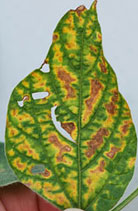|
|
Soybean producers should look for sudden death syndrome, or SDS, and brown stem rot when scouting fields over the next few weeks in order to identify the fungal diseases and prevent future yield loss due to disease.
Soybean fields across Indiana have started to show symptoms of SDS, and brown stem rot is another disease sometimes confused with SDS. Yield loss from the diseases can be minor or major, depending on how widespread they become - which is why identification is key.
"There is no in-season management for these diseases, but it's important to identify fields that have the diseases to prevent yield loss in future years," said Kiersten Wise, Purdue Extension plant pathologist. "It can help to know which fields have the diseases so producers can select disease-resistant varieties for the next time the fields are planted to soybean."
Listen to Wise discuss why scouting for SDS and BSR is important.
Symptoms of SDS, caused by the fungus Fusarium virguliforme, aren't typically noticed until August, even though the fungus infects plants early in the growing season during wet, cool weather. Many soybeans emerged from wet soils this spring, so Wise cautioned producers to be on the look out for SDS and brown stem rot.
The diseases have similar foliar symptoms, which include yellowing or browning between the leaf veins.
Listen to Wise discuss differentiating between SDS and BSR in soybean.
"You can tell the difference between SDS and brown stem rot by examining the internal tissue in the lower stem of the plant," Wise said. "The first step is to pull up the plant and split the lower stem. With SDS you'll see discoloration in the cortex of the stem and root. Whereas with brown stem rot you'll see a discoloration in the pith."
The pith of plants affected by SDS will remain white. In some instances, both diseases might be present in a plant, which can make diagnosis difficult.
Identifying the diseases can help producers make good management decisions the next time a particular field goes into soybeans.
"For instance, if you know a field has the disease, you can select a variety for next year that will be less susceptible to either disease," Wise said. "It is important to be sure if you have SDS or brown stem rot since varieties that have resistance to brown stem rot might not necessarily be resistant to SDS, and vice versa."
Each seed company has varieties rated for SDS and brown stem rot resistance, so producers should contact their local seed dealers when selecting resistant varieties.

 Foliar symptoms of SDS in soybeans. (Purdue University photo)
Foliar symptoms of SDS in soybeans. (Purdue University photo)




Post a comment
Report Abusive Comment